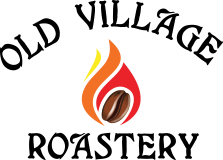The Forge Roasting Process
Roasting While modern coffee roasters typically use propane or natural gas as their source of heat, Forge Roasting relies on radiant heat from the active flame and glowing embers of a wood fire. Radiant heat penetrates the bean much deeper which allows the core of the bean to roast without compromising or scorching the outer regions of the bean. Managing this radiant heat of the Forge Roasting process takes a good bit of experience, intuition, and yes, a bit of luck. The result: coffee beans that are gently roasted to perfection and a cup of coffee reminiscent of a bygone era.
